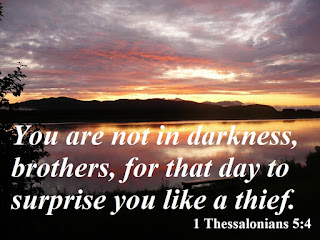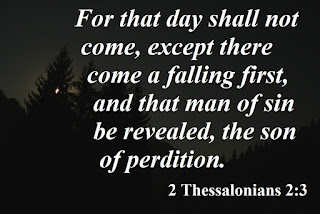Children of the Day
Children of the Day (Prelude to chapter 11)
 |
| Day breaks in Aniak, Alaska |
Because this is a book of prophecies of the end times,
students of eschatology search from beginning to end, looking for the rapture
of the church. They want to know where and when it occurs among all the events
in the book. I used to hear frequently that John represented the church, when
he heard a voice like a trumpet that said, “Come
up here…” (v.4:1). I don’t hear that claim very much now and I don’t know
the reason why. However, the majority of people, who hold the view that
Revelation prophesies of future events and of a literal Millennium, still feel
that the rapture takes place after the messages to the churches in chapters 2
and 3 and before the scene that takes place in chapters 4 and 5. That is called
the pre-tribulation rapture view….
simply that Christ will come for His church before Daniel’s 70th
Week.
Others believe that the rapture takes place, when Christ
returns as described in Revelation 19 at the end of the tribulation; that is
the post-tribulation rapture
viewpoint. Verse 7 of that chapter announces the Marriage Supper of the Lamb, after
which Christ is presented, sitting on a white horse. They teach that, almost
simultaneously, the church will rise to meet the Lord in the air and then will
follow Him to earth. They will enter with Him into the Millennium and reign
with Him upon the earth.
One things is for sure: Because of the spiritual nature
of the writer, John, and because of the style of his book, the rapture is not
easy to find here. The apostle Paul laid it out so clearly for us in his
epistles (that I asked you to contemplate at the end of the last chapter), but
that is not John’s way. With the help of Paul’s descriptions of the rapture, we
must try to find the place, where it occurs in Revelation. A friend of mine,
who taught expertly on this subject, used to say: “There is no other place like
this place, anywhere near this place, so this must be the place!” There is
humor in that remark, but it describes quite well the puzzle that we will try
to solve.
I am going to try to give to you a third viewpoint. It is
called the mid-tribulation rapture view.
I hope to present it humbly, without controversy or strife in my spirit. I do
not consider myself an expert, but I will do the best that I can. My intention
is that you will take this opinion into account and weigh the evidence against
the evidence of the other viewpoints.
Personally, this subject has impressed me in a way that
perhaps will not be the same in your case. It was in 1956, when I was only
twelve years old, that our family, our church and many other Christians entered
into a wonderful moving of the Holy Spirit. One of the characteristics of this
time was a clarity and unction upon the teaching of the word. It was then that
my father and a number of his associates in the ministry read a book on
mid-tribulation rapture. They were so moved by this interpretation of prophecy
that they changed their views and moved from proponents of pre-tribulation
rapture to that of mid-tribulation rapture.
Their teaching affected me more profoundly than any
teaching that I have heard on the subject since. I have listened carefully to the
teaching of the other positions, many times very well done by close friends and
other Christians that I respect. Here, I will briefly state an important point
concerning all biblical doctrine: The best debater is not necessarily the
bearer of truth. We must look at the content, over the abilities of the speaker
or writer, and always come to a conclusion by the weight of the evidence.
I recognize that what I will write is a theory, as all
students of eschatology should, and I respect the
other two opinions. Every position
has its strong points, as well as its weak points. It is totally wrong to break
fellowship because of differences of opinion concerning prophecy, although
there are churches that will not give you membership, unless you adhere to
their point-of-view. That practice, I think, approaches fanaticism.
 |
| Moon over Romania |
Next, it seems to me that if we look at all the events of
the seals and the trumpets chronologically, one strictly following another, we
are going to run into serious difficulties. It is better that we look at the
nature of these judgments, rather than the exact timing of them. It is not
until this chapter that we begin to see a clear chronology take place.
Another hurdle that must be overcome is that of the
imminent return of Christ, as taught by the pre-tribulation position. For this reason, in preparation for chapter
11, one of the portions that I asked you to consider is 2 Thessalonians 2:1-3: “Now concerning the coming of our Lord
Jesus Christ and our being gathered together to him, we ask you, brothers, not
to be quickly shaken in mind or alarmed, either by a spirit or a spoken word,
or a letter seeming to be from us, to the effect that the day of the Lord has
come. Let no one deceive you in any way. For that day will not come, unless the
rebellion (defection from the truth; apostasy) comes first, and the man of lawlessness is revealed, the son of
destruction.”
Paul challenged a false teacher or teachers in his day,
who even seemed to use a counterfeit letter, as if it came from Paul himself.
It claimed that, which Paul is denying here, that the day of the Lord had come.
There can be no doubt that the letter was referring to the rapture of the
church – “the coming of our Lord Jesus
Christ and our being gathered together to him.” He had taught concerning that
event in his first letter, 1 Thessalonians 4:13-18, which I also asked you to
read in preparation for this chapter.
Paul maintained that two things must take place before
that event: 1) There must first be a general apostasy, a word, (apostasia) which in Greek is closely
related to the word for divorce (apostasion).
We may conclude, then, that the apostasy, of which Paul writes, is a divorce or a departure from Christ by the nominal church. I believe it will be
in enormous proportions and that we are on the brink of apostasy at this moment.
I also believe that we are living in the time, when the
Laodicean Church is the dominating one (you may want to refer to our study of
the Laodicean Church in chapter 3:14-22). Jesus’ said that, if they did not
repent, he would vomit them out of His mouth. He then makes a call from outside
the church to the individual within: “Behold,
I stand at the door and knock. If anyone hears my voice and opens the door, I
will come in to him and eat with him and he with me” (Rv.3:20). Individual
Christians, serious and sincere, tired of the deception and corruption in the “church”,
will respond to the call. There will enjoy wonderful fellowship with Christ and
with brethren of like mind, while Laodicea blends into the world system and
ends up in Babylon. Gray areas will disappear and black will become black, and
white will become white.
2) The man of lawlessness, the son of destruction, refers
to the antichrist. I see no other possible definition and Paul is telling us
that, not only would he be in existence, but that he would be revealed, when the church is gathered to
Christ at the rapture. The antichrist will be a force to be reckoned with at
the beginning of Daniel’s 70th Week, but his revelation as the man
of lawlessness, takes place at the abomination of desolation in the middle of
the week. This is very clear in Daniel 9:27: Therefore the rapture of the
church cannot be totally imminent.
After speaking of the rapture at the end of chapter 4, in
the next chapter, Paul teaches about the times and the seasons of Christ’s
coming. He said that He would come as a thief in the night… but please notice,
to whom He will come in that way. In verse 3 of chapter 5, the subject of the
phrase is people or, in other
versions, the pronoun they… “while people
are saying, ‘There is peace and security…’” and the sentence continues,
“then sudden destruction will come upon them…”
However in verse 4, speaking to Christians, Paul states, “You are not in darkness, brothers, for that day to surprise you as a thief.” He makes it very
clear, “You are all children of light, children of the day” and then
concludes “God has not destined us for
wrath, but to obtain salvation through our Lord Jesus Christ.” The children
of the light are aware of the days in which they are living, and although no
one knows the day nor the hour of His coming, we can know the times and the
seasons. This is why I encourage the study of end-time prophecy and it is also
a reason, for which I believe that the rapture will take place in the middle of
Daniel’s 70th Week. We will now look closely at the signs given us
in chapter 11, relating to that time.
Subscribe to:
Post Comments (Atom)









Post a Comment